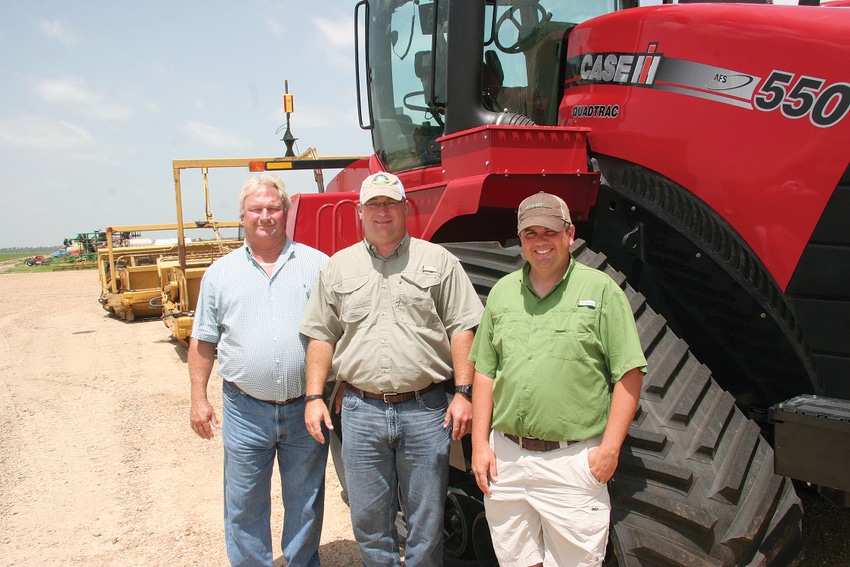
Good drainage, new technology helping Bowers Farms continue to move ahead
“Van has a patch, and I have a patch; it’s about 50-50,” said Trey Bowers. “We got into row rice because we believe the day is coming when we’ll be limited in how much water we can pump. We’re doing better — we’re watering in 24 hours what it used to take us four days to do.”
August 10, 2014

The rains that fell in eastern Arkansas the weekend of June 28-29 — more than 12 inches in places — caused some farmers to have to replant a total of 100,000 acres and others to “zero out” their fields and file crop insurance claims.
That might have been the case in the river bottoms around Corning, Ark., near the Missouri state line in times past. As it was, water got over a few fields of soybeans, but the vast majority of other crops escaped major damage.
“We need .2 or .3 of an inch to wash some of the mud off the soybeans,” said Doin R. Bowers, who operates Bowers Farms with his son, Trey, just east of Corning. “They don’t do well when it starts warming up, and the plants need to respire. But the damage wasn’t anything like it could have been a few years ago.”
Doin says the fields surrounding the farm headquarters received 7.8 inches of rain the weekend the skies opened and dumped copious amounts across the region. The reason the farm didn’t experience extensive flooding — vastly improved drainage.
Drainage has always been critical to the Cache River bottoms west of Crowley’s Ridge, the unusual geological formation that runs from southeast Missouri down through Clay County to the Mississippi River at Helena, Ark. Much of the area was not cleared and made accessible to farmers until drainage districts were created beginning around 1910.
Since then, farmers have continued to build on such efforts, including creating drainage districts such as the one that led to significant improvements in the Corning area.
“About 12 years ago, we created a taxing district,” said Doin. “Fifteen years ago, if we had received the kind of rains we had at the end of June, we would have been in trouble.” (Water from the Cache River and Central Clay Districts now go to the Clay County District and then into Greene County.)
‘One crop in four’
“Back in the 1970s, we lost one crop in four to flooding, and we didn’t have much crop insurance coverage then,” said Doin, whose father and grandfather farmed in the area before him. For years, they grew cotton on the sandy ridges that ran through the area. They were limited to about 10 acres by the topography and the equipment available to them.
As the drainage and equipment improved, the Bowers have expanded their crop acreage, going from a small allotment for rice and 25 acres of soybeans to 4,400 acres of rice and a changing mix of corn, soybeans and wheat to fill out the remainder of the 12,000 acres the father and son farm.
“We’ve been in rice for 48 to 50 years,” said Doin. “When my father started growing rice, he had an allotment of 38 acres. We’ve added to that as we’ve had opportunities to expand and the equipment became available to us.
One of their long-term goals is to improve their ability to get water on and off their fields. They’ve been land-levelling from 160 to 200 acres or more per year for the last several years.
“It began as having something for our labor to do between layby and harvest,” said Trey. “But we’ve seen benefits from putting the land to grade.
They also grid sample their fields with the help of consultant Van Dawson, agronomist at Bowers Farms. The grid sampling at 2-acre intervals allows them to see changes in soil texture across their field and to adjust their fertilizer applications, accordingly.
Furrow-irrigated rice
Dawson and Trey Bowers are working on a 300-acre “experiment” with furrow-irrigated rice. They are hopeful the unconventionally-watered rice, which was planted on a field with a steeper grade than others on the farm, will enable them to use less water in their operation.
“Van has a patch, and I have a patch; it’s about 50-50,” said Trey Bowers. “We got into row rice because we believe the day is coming when we’ll be limited in how much water we can pump. We’re doing better — we’re watering in 24 hours what it used to take us four days to do.”
The Bowers operation is also trying new technology such as a surge valve that allows them to pulse water across 20 acres a time. A butterfly valve in the apparatus allows them to push water first in one direction and then another to let the water soak in before sending another wave down the rows.
They are also proponents of using PHAUCET (Pipe Hole and Crown Enhancement Tool), a program that helps growers make more efficient applications of water to rice and other crops, and they’ve been using flexible irrigation tubing for about 15 years.
They do not plan to grow rice under a center pivot. Although center pivot rice was first grown not far from Corning, they don’t believe the systems will provide enough water to keep rice ground wet. “The soil can get so dry, water won’t penetrate below the soil surface,” says Van.
They’re hoping row rice might also help solve another growing problem in the region — pigweed or Palmer amaranth on levees.
Preventive herbicide
“We’ve got to be able to get a preventative herbicide out first, or you can’t get them,” says Trey. They’re planning to apply Sharpen, a new broad-leaf herbicide from BASF and 2,4-D with a levee sprayer with a 10-foot boom to take out escaped pigweed.
When Roundup Ready crops first came on the scene in the mid-90s, the Bowers held off planting them. But they switched over when they saw how easy it was to control large weeds in the Roundup Ready system.
“Roundup Ready crops made us all look good at first,” said Doin. “Now we’re having to go back to some of the weed control techniques from the past.”
The Bowers have been growing Clearfield rice since it arrived on the scene in 2002. When possible, they try not to grow Clearfield varieties or hybrids back-to-back, preferring to rotate with soybeans to help control red rice and prefer the technology.
“We had Clearfield rice on the same ground because of red rice,” says Trey “Then we went back to soybeans last year and cleaned it up. We’re trying to avoid doing that.
“If we do Clearfield like we did Roundup, we’re going to have problems with that technology as well,” says Doin.
The Bowers say they will continue to change as new technologies evolve. Years ago, the county Extension agent told Doin he was planting too much seed. Doin gave the agent 40 acres to plant about half the amount of seed per acre Doin had been using. “He beat me by 10 bushels an acre and my rice went down,” says Doin.
Sheath blight treatment
They’re also applying Sercadis, a new fungicide for sheath blight, on 5 acres this year. “We think it may help with milling quality,” says Dawson. “We don’t have much sheath blight because we grow so much hybrid; blast is more of a problem. But it may be that it helps with overall plant health.”
And, while they’ve been expanding their operation at the rate of around 1,000 acres a year in the last decade, the Bowers say they will weigh any further plans for expansion carefully.
“The problem is the labor,” says Trey. “We can’t find new help. We have two guys in their 70s who are driving equipment for us now. They still like to work, and they are very meticulous in what they do.”
“It would take a group effort to make it work,” said Doin. “But the fact is you still have to have someone sitting on a tractor, making decisions about what to do next and how best to do it.”
About the Author(s)
You May Also Like





